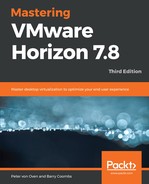The next stage in the installation and configuration process is performed using the View Administrator console and, like a standard View setup, involves creating pools and entitlements. However, rather than creating pools for virtual desktop machines, this time we are going to configure application pools.
Before we do any of that, the first thing we need to do is to set up a farm that contains the newly built RDSH server. To do this, perform the following steps:
- Open a browser and connect to the View Administrator. In our example lab, the address for the View Administrator is https://hzn7-cs1.pvolab.com/admin/.
- Log in to the View Administrator using the administrator account and password.
- You will now see the View Administrator Dashboard, as shown in the following screenshot:

- Expand the arrow for Resources from the Inventory pane on the left, and then click on Farms (1).
- Now click the Add… button (2).
- You will now see the Add Farm configuration screen, as shown in the following screenshot:

- In the Type section, click the radio button for Manual Farm.
- Click the Next > button to continue.
- You will now see the Identification and Settings configuration screen, as shown in the following screenshot:

You need to fill the details, as shown here:
- In the ID box, enter an ID for the farm that will be used by View to identify it. In the example lab, this is called Horizon-Published-Apps.
- In the Description box, enter an optional description for the farm and then, from the Access Group dropdown, select an access group if you have one.
- Next, under Farm Settings, set the Default display protocol to PCoIP and from the Allow users to choose protocol dropdown, select Yes.
- In the Pre-launch session timeout, leave this as the default setting of 10 minutes. Pre-launch allows apps to load ahead of a user clicking to launch it. This option configures a timeout.
- In the Empty session timeout, enter a time after which the session should timeout when not being used, and then in the When timeout occurs box, from the drop-down menu, select what happens at timeout. In the example lab, this is set to disconnect the user from the session.
- The next option is whether or not to Log off disconnected sessions. This option will log off any disconnected sessions. In the example lab, this is set to Never happen.
- Check the Enabled box to allow HTML access to desktops and applications on this farm.
- Finally, check the box for Allow Session Collaboration. This only works when you connect using the Blast protocol.
- Once you have completed the configuration options on this screen, click the Next > button to continue.
- You will now see the Select RDS Hosts configuration screen from where you select which hosts are going to participate in this farm, as shown in the following screenshot:

- Click and select the rdsh-apps.pvolab.com server entry and then click the Next > button.
- You will now see the Ready to Complete screen, as shown in the following screenshot:

- Check that the settings you have entered are correct, and then click the Finish button.
You have now successfully created a new farm configuration for the hosted applications, as shown in the following screenshot:

You will also see in the RDS Farms section in the System Health box on the View Administrator Dashboard that the farm name, Horizon-Published-Apps, and the server name, rdsh-apps.pvolab.com, are now listed, along with a green box to show they are working correctly:

In the next section, we are going to create an application pool.
